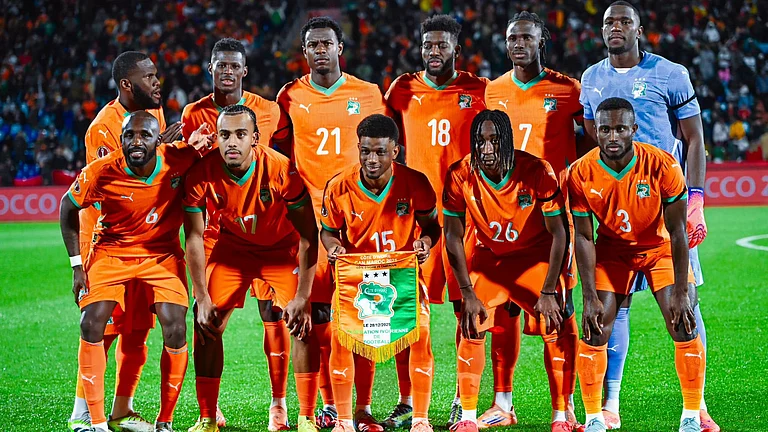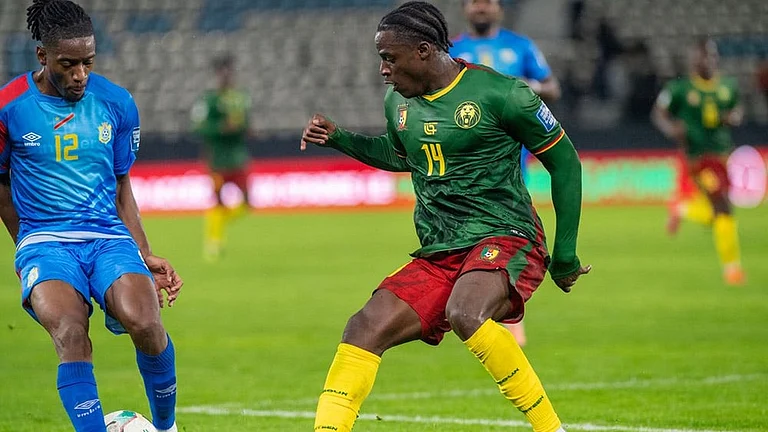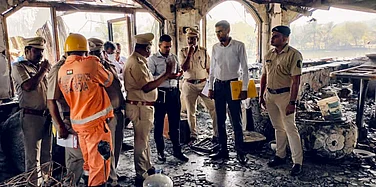The road to Bandipora is pacific, devoid of traffic on the morning of October 10. Shops along the way north from Srinagar are shut, while people can be seen congregating in small groups to talk to each other. Hardly promising portents for the second phase of Jammu and Kashmir’s urban civic election, held after a gap of 13 years and boycotted by major regional parties such as the National Conference (NC) and the People’s Democratic Party (PDP). A cacophony of reporters descends on the village of Anderkot in the Sumbal area of Bandipora district in north Kashmir—the only polling station in the vicinity where they might catch a glimpse of that rara avis, the voter. In the neighbouring Hajin area, none of the 13 wards is even contested.
On approach, one sees that Anderkot is indeed a fortress, ringed with three-tier security: army on the outside, CRPF in the middle and BSF on the inside. Concertina wire on all sides of the polling booth tops off this concentric defence, and voters may pass the portcullis only after a frisking. But the big sticks have come with little carrots: the BSF personnel at the booth are giving out biscuits to some children, who are favourably impressed.
As they enter the polling booth, the beaming faces of Bandipora deputy commissioner Shahid Choudhary and senior superintendent of police Sheikh Zulfikhar announce that they’re pleased with their work, having created an electoral oasis amid a desert. A BSF jawan recounts the horrors of this arid land: when he was posted in the Papachan area during the first phase, on October 8, nobody had turned out to vote—until the BSF forced 60 villagers to do so. “But people here (Anderkot) are friendly, and they are voting happily,” says the jawan, Ramesh Yadav.
Such promising pockets weren’t quite absent from the first phase either: the frontier district of Kupwara and two polling booths in Baramulla town’s Sangri area had decent turnouts. Generally, these elections saw people cast votes in frontier areas like Uri, where the army controls almost every aspect of life, and in places like Anderkot and Sangri where local candidates were in the fray. But these are pinpricks of light in a sunless sea; overall turnout in the Kashmir region was a mere 8.3 per cent in the first phase, 3.4 in the second, 3.5 in the third and 4.2 in the fourth and final phase held on October 16. Of the Valley’s 598 wards, nearly half went uncontested. Mobile internet was shut down during the elections, there were no campaigns, and people didn’t know the names of the candidates; most of these incognito hopefuls were holed up either in Jammu or in Srinagar.
This disinterest on the voters’ part is a new phenomenon, but perhaps it can be said to rhyme with the past. Political analyst Ahmad Ali Fayaz says the current government has discredited electoral democracy in the state after two decades of credibility. “Who will defend this sham in the name of elections in Kashmir,” he asks, adding that the exercise has a parallel in the “farcical” polls held in the state from 1947 to the 1970s. The only similar instance in the recent past may be the Srinagar byelection of 2017, when Farooq Abdullah won the Lok Sabha seat with a turnout of seven per cent.
In 2008, after the summer protests over the transfer of land to the Shri Amarnathji Shrine Board, and the subsequent economic blockade of the Valley in which 60 youths were killed and thousands wounded, separatists expected the people to boycott the assembly polls in November and December—but the people proved them wrong, and came out to vote in droves. The 2011 panchayat elections, held in the wake of the previous year’s unrest that saw 112 youths killed—and, again, thousands wounded—tell much the same story, while the 2014 assembly elections saw a turnout of 70 per cent in the Valley.
So, what has happened in the past four years to depress turnout and force parties like the BJP to import candidates from Jammu? “People were victimised by the BJP government. The hard policy towards Kashmir pushed people to the wall, and the end result is that no one is interested in the polls,” says Usman Majid, Congress MLA for Bandipora. Usman, a former counterinsurgent-turned-mainstream-politician, claims that the previous PDP-BJP government’s “lopsided” development policies also led to disinterest among the people. Imtiyaz Parray, Congress candidate in ward eight of Bandipora’s Hajin area in this election, says the government failed to provide a peaceful atmosphere for voters, leading to uncontested elections and the absence of candidates; he himself won uncontested. His father, Kuka Parray—once the face of counterinsurgency in the state—became an MLA and was killed by Hizbul Mujahideen militants in a 2003 ambush. Imtiyaz, who merged his father’s Jammu and Kashmir Awami League into the Congress in 2010, goes on to allege that the Centre didn’t listen to the NC and the PDP, which wanted some assurance on the status of Article 35A of the Constitution before ending their boycott of the polls.
On the other hand, Yasir Reshi, a PDP rebel legislator in the upper house of the J&K assembly, says the state’s two mainstream parties—the NC and the PDP—had blackmailed the Centre for a long time, but now, “Delhi has shown them what they can do without them.” He does, however, concede that the disinterest demonstrated by the depressed turnout shows that the people have been pushed to an extreme position. As this election was about local issues, village and urban problems, the lack of participation reveals complete alienation in the turbulent Valley.
Separatist calls to boycott most other elections since 1996 were louder than they were this time—but they never had much impact. Seeing the people’s participation during the 2008 assembly polls, senior separatist leader Syed Ali Shah Geelani criticised People’s Conference leader Sajjad Gani Lone, who was on the separatist side at the time, for fielding proxies. Lone hit back by describing Geelani as the biggest hurdle in Kashmir’s path to Azadi (‘liberty’). He eventually went on to renounce separatist politics and join the mainstream. According to separatist leaders, the Centre launched its electoral experiment in 1996—following six years of President’s rule in response to the onset of the armed insurgency—in order to deflate ‘Azadi sentiment’ in the Valley. During the 1996 elections, the candidates were ensconced in the security forces’ camps, while the security forces marched voters in various places to the polling booths. But even then, turnout was far better than in this election.
“This time there was total disinterest. Whether we like it or not, the traditional players do generate that local flavour. Someone I know, who has always voted—even in the early ‘90s—just because he felt it was his right and privilege, did not do so today as he did not even know who the candidates were,” says a senior police officer. He adds that a new generation of “friends of Delhi,” who think they can replace the traditional mainstream parties, has certainly emerged—although the government is not so naive as to think that they will be able to translate this into something big.
The 1987 assembly election, widely considered to have been rigged by the NC government, is seen as the root cause of the armed insurgency in Kashmir. Decades down the line, what will come of an election rigged by voter apathy?
***
- The BJP won at least 60 seats unopposed and gained control of at least seven municipal committees in the Valley.
- Regional parties boycotted the election due to concerns about Article 35A, which protects the state’s special status.
- Jammu and Ladakh saw high turnout, bringing the total figure to 35.1 per cent, or 5.97 lakh out of 17 lakh eligible voters.
***
Underwhelming Numbers
First phase
- 8.2% polling recorded in the Kashmir region
- 92 of the 149 wards saw no polling
- 69 wards had candidates elected unopposed
Second phase
- 3.3% polling recorded in the Kashmir region
- 117 wards out of 160 saw no polling
- 56 wards had no candidates
- 61 wards had candidates elected unopposed
Third phase
- 3.5% polling recorded in the Kashmir region
- 121 wards out of 151 saw no polling
- 49 wards had candidates elected unopposed
Fourth phase
- 4.2% polling recorded in the Kashmir region
- 96 wards out of 132 saw no polling
- 52 wards had candidates elected unopposed
By Naseer Ganai in Bandipora and Baramulla


























